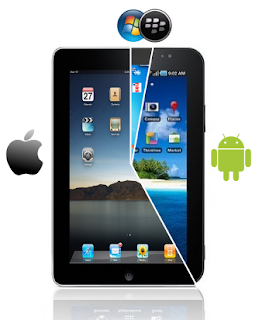Figures were released today highlighting the rapid growth of the worldwide tablet market. Most of the reports I’ve read focused on the increasing success of Google’s Android operating system in challenging Apple’s iOS (which powers the iPhone and iPad).
Today’s numbers come from a firm of analysts called Strategy Analytics, giving Android tablets a 39% share of global sales in the final quarter of 2011, with Apple taking 58% of the pie. The remaining 3% of the crumbs were fought over principally by Microsoft and RIM. In the same period a year ago, Apple took 68% of the market it effectively created, leading to stories like the one I saw at lunchtime on BBC News 24, suggesting that Apple’s grip was loosening.
To my mind, the most important piece of information is not the platform split but the topline growth. The fourth quarter saw a year-on-year increase of 150% – from 10.7m to 26.8m units sold around the world – accounting for more than a quarter of global personal computer shipments during the quarter. If losing your grip means increasing sales from 7.3m to 15.5m units, I’d like a grasp as slippery as Apple’s.
What the figures really show is that in a relatively short space of time, the tablet computer has completed its journey from rare and expensive curiosity to cornerstone of the technology market.
Incidentally, not everyone thinks the above numbers are especially solid. With so much money at stake, many of the big players are keeping their cards discretely covered. While Apple publishes its sales figures, the bigger Android makers simply aren’t saying how many tablets they’re selling. As The Guardian’s report today highlights, there surely must be more than a little extrapolation (otherwise known as guesswork) in Strategy Analytics’ figures.
We can be certain, though, that the tablet market is now an established, big and growing part of the computing landscape. And as it grows, it will naturally diversify if only to cover a greater range of price points. Apple will no doubt continue to hold the high ground (and the highest prices), but other suppliers and other platforms will carve out market share at margins Apple won’t want to tolerate. While the market was started by the iPad alone, and may eventually converge onto a single operating system when tablets become properly mature, for the moment, proliferation is unavoidable.
Companies hoping to serve their customers on tablets need to be aware of the fragmented state of the market. It’s tempting to think that Apple has the biggest slice and that it’s therefore good enough simply to write your apps for iOS and ship them through the iTunes store. But if we return to Strategy Analytics’ estimates, 42% of new buyers just made a different platform choice. They won’t thank you for ignoring them.
Whatever you’re building on the tablet, and on any mobile computing device for that matter, make sure you do it in as agnostic a manner as possible. Design your apps – and choose your software suppliers – with diversity in mind. It might make things more complicated in the short term, but you’ll be thankful eventually – and probably much sooner than you expect.

No comments:
Post a Comment